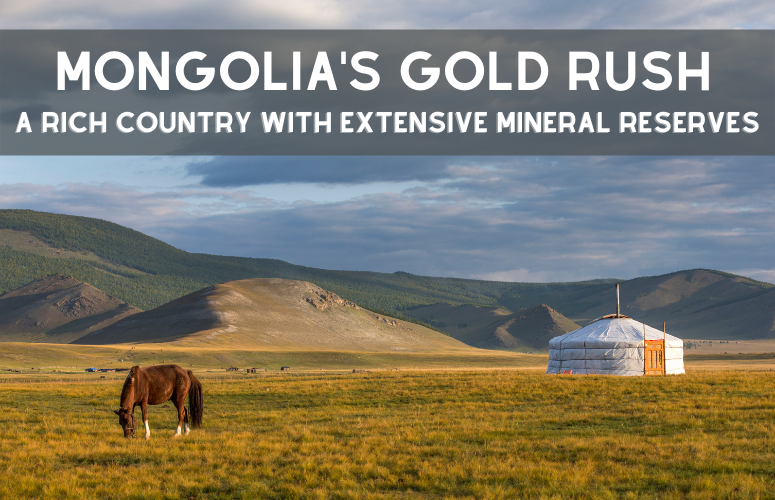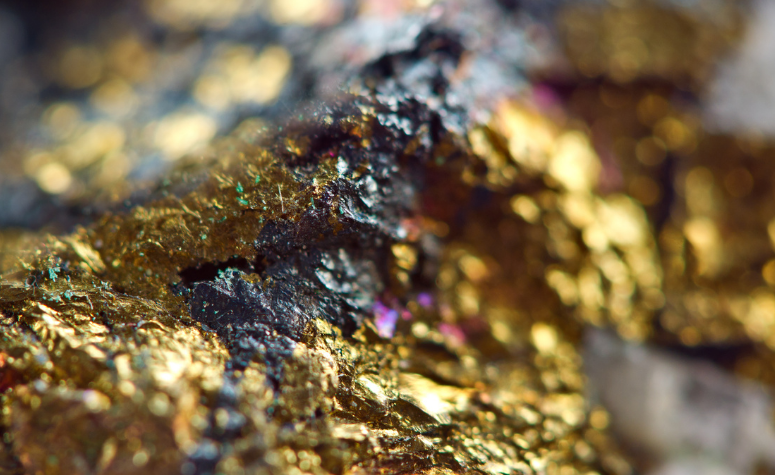
“Conquering the world on horseback is easy, it is dismounting and governing that is hard.”
Viewed in a different light, Genghis Khan’s thoughts on conquest can also apply to the development of a country’s natural wealth. Many countries are rich in resources, but have yet to establish sustainable ways to harness them.
The very land from which Temujin hails is one such example of this. Mongolia has been identified by the International Monetary Fund (IMF) as one of the 29 developing countries most rich in natural resources, not least of which is gold. However, the gold rush in the “Land of the Blue Sky” only took place in recent years. Let’s take a look at Mongolia’s journey towards unearthing its mineral wealth.
A Rich Country of Many Minerals
Landlocked between Russia and China, Mongolia possesses abundant deposits of coal, fluorite, copper, gold and silver. Coal has largely been driven by domestic demand, with some of the more recent fields in Nalajkh and southern Gobi exporting their produce to other countries. However, these market-oriented developments have only taken place in the recent century.
Historically, Mongolia’s economy relied on agriculture and rural herding activities, but recent years have brought to light the large reserves of untapped minerals and a shift in priorities has emerged. This has led to a great boom in economic activity, with the mining sector accounting for roughly 80% of Mongolian exports today. The shift in mining regulations has also driven a huge influx of foreign investment into the country.
Many base metal ores have formed in Mongolia because of the nature of its tectonic history. Basement rocks formed during the Paelozoic Era, but tectonic shifts and collisions of the continents over the years have significantly changed its terrain. The country’s geography ranges from mountainous regions to the north and west, while the Gobi desert can be found to the south. The rest of the Mongolian Plateau is characterized by grassland steppe. Lead, copper and gold can be found all throughout the province, which is significant when one accounts for the fact that Mongolia is the world’s 18th largest country.

Recent Mining Activity
Though its estimated reserves are high, Mongolia has only seen minimal mineral activity before the 21st century. It was only in 2004 when foreign investment began at the Boroo deposit, which was the first hard rock gold deposit in the country. Located in northern Khentei, about 70 miles northwest of Ulaanbaatar, gold-sulfide and gold-quartz vein mineralization occurs here.
The Canadian mining company Centerra began commercial production at the outset, and was recorded to have produced up to 66 tons of gold up to 2017. This mine alone is estimated to have contributed around 5-7% of the country’s GDP due to the large capital influx it has attracted. Currently, the Boroo project is being run by a Singaporean firm called OZD Asia and continues to produce gold. Another mine called Gatsuurt is about 35km away from Boroo and is thought to have similar mineralization profiles.
Another mine well worth noting is the Oyu Tolgoi, which is one of the world’s largest copper mines that also produces gold and silver as by-products. Located in the South Gobi desert, Oyu Tolgoi is estimated to contain around 2.7 million tons of copper and 17 million ounces of gold. It was discovered in 2001 and studies showed that apart from copper and gold, silver and molybdenum also occur within the area. Around 12,000 kg (425,000 ounces) of gold are estimated to be produced annually, and the mine employs a massive workforce of 3,000 to 4,000 laborers in order to achieve this. This is one of the largest undertakings of the country and is being financed by the Mongolian government, the Rio Tinto Group and Ivanhoe Mines of Canada.
Placer Gold
Placer mining is also experiencing an increase in activity. The northern reaches of Mongolia, particularly the Zaamar district in the North Hentii gold belt, are generally more prolific for placer gold. This area drains the Tuul river and more than 40 companies have established operations alongside it to recover alluvial deposits.
Placers can be found along the riverbanks for a 40km stretch, as well as on the river’s right-bank tributaries. Hailaast, Bayangol and Tsagan bulag are a few notable valleys with the largest placer deposits near the Tuul river. Gold grains in Hailaast are coarse and medium in size. Placers can also be recovered in Bayanhongor belt, around 50km northwest of Bayanhongor town.
The Jargalant placer deposits near the mountain range of the same name were mined during the 1990s and continue to produce fruitful bounty until today.
Mongolia has abundant minerals and has successfully attracted foreign interest and investment. However, changes in infrastructure and regulation are needed to ensure that production estimates will be realized properly. Though these things will take time, it is not often that we see a massive amount of natural resources, government support and private sector initiatives all in one place. The next decade will tell us whether Mongolia’s rare combination will lead to a thriving, sustainable mining industry in the years to come.
